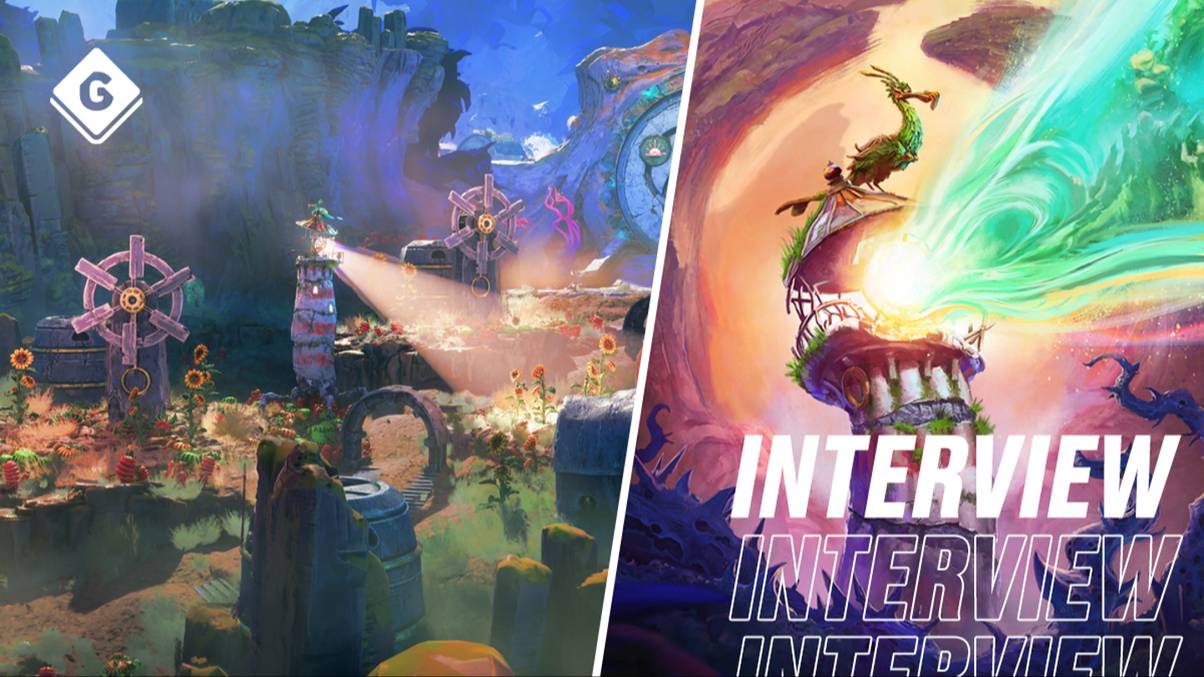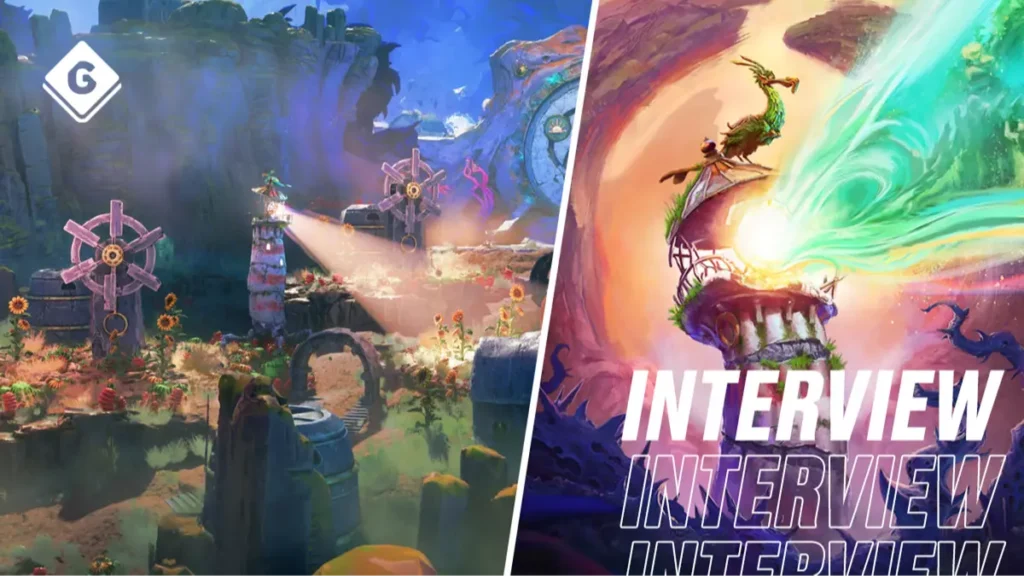
Keeper is the type of game Xbox has been missing for so many years.
Recently launched on Xbox Game Pass, Keeper was developed by Double-Fine, the studio that brought you games like Psychonauts, Brütal Legend and more. What defines a Double Fine game, at least in my opinion, is an emphasis on experimentation and Keeper is arguably the best example of Double Fine’s knack for out-of-the-box game design so far.
Keeper’s lead protagonist is a lone, old, decrepit lighthouse standing vigil at the edge of an island. After a chance encounter with a bird named Twig, the lighthouse topples over before sprouting vine-like legs and wooden eyebrows before standing up and taking its first steps. The lighthouse’s motives aren’t explicitly stated but after stumbling around and getting used to its new appendages, something at the peak of the island captures its attention, compelling it to scale the gargantuan mountain for reasons unknown.
It’s as wild as it sounds and I was eager to learn more about this fantastical world Double Fine had concocted. To do this, I spoke to the game’s Creative Director Lee Petty.
My first question had to be about the lighthouse itself. Even in my wildest dreams I don’t think I’d have ever predicted a lighthouse would make a good video game protagonist, but here we are.
“It’s an obvious choice, right?” began Lee, “the game is about a few different things. And one of the things it’s about is change.”
Lee then explained how Keeper is a game devoid of human life but signs that we once existed are still there. There are houses, roads, cars, echoes of a humanity that once ruled the planet but have long since gone. Even the lighthouse itself is a man-made creation that no longer has purpose.
“When I knew I was going to sort of set the game in a post-human era on this island, kind of imagining in a surreal fever dream sort of way how life might evolve without us, I thought of something that had been left behind, that had no purpose anymore.
“The lighthouse was one of those ideas because obviously there’s no ships coming, there’s no humans. It remains stationary. What’s it going to do?”
Once the player gets control of the lighthouse, they need to learn to control it with it wobbling around like a newborn and this was apparently very much intentional. This lighthouse might be old but it’s never been alive before, it has been born again.
“A big part of the game is the unexpected. And what better way than to start off with the lighthouse doing something that it was never designed to do, walk?”
That physicality is everything to Keeper’s story as it’s a tale not told in a conventional way. There is no dialogue, no award-winning voice performances to carry the narrative, it’s all body-language from something that doesn’t even have a human body.

Interpreting The Island
Keeper’s stage is an island that clearly once belonged to humanity, but has since returned to nature. Players get no context whatsoever as to where the humans have gone or how long it’s been since their disappearance, only that they’re not here and life is thriving without them.
I’ve always been fascinated by this kind of storytelling, where history haunts the narrative but is never explicitly laid out for you. In my interview with Lee I was eager to learn more about the challenges that arise with crafting a story that needs to be inferred rather than heard.
“I think so many things now, especially in games, are so overly, literally expressed to the player. And I think we’re after something that was a little bit more, ‘is this actually happening? Is this a fever dream?’ Is this meant to be taken literally? Is it metaphorical?, kind of blurring some of those lines.”
Lee went on to explain how there was a conscious choice to use as few words as possible to leave everything open to interpretation, and how it “really changed everything about the game.”
“The entire way the puzzles work, our choice for how we wanted to use the camera, because you’re just not able to do things like here’s a bunch of chores and a waypoint and a mission objective, we removed all of that. So you have to communicate those in other ways just so people can get through the game. The themes are told more through animation and the environment and music and sound than they probably would be otherwise had we had dialogue.”
This approach was woven into the history of the island as well, with Double Fine wanting to “suggest a rich history” rather than provide players with a timeline of events.
Lee described the world-building as a “human footprint” but one that didn’t really have positive or negative connotations to allow for theories to bloom. “What I didn’t want to do is create a post-apocalypse.”
A few breadcrumbs are shared in the form of glyphs, broken sculptures that can be pieced back together. This is the closest the game gets to straight-up telling you what’s happening and it only does so through the achievement description, and even then they’re short and sweet to not give too much away.

Know Thy Enemy, Or Don’t, I’m Not Your Keeper
Something that struck me about Keeper is its lack of antagonism in the traditional sense. There is an antagonistic force but it’s not as simple as a fight between good and evil. Like the rest of the story, the lines get blurry. It feels like combat in games nowadays is taken for granted and while you often need some sort of threat to allow for some stakes, I think we’ve been spoiled by soulslikes and shooters to the point where we think a game’s conflict is the be all and end all.
Speaking about the lack of physical enemies, Lee said “we wanted to make what we are calling a ‘weird but chill’ game and that kind of basically means that it’s a game that does some unexpected things, that’s one of the ways we keep people interested in the game.
That can be a challenge to get people on board with if they’re also dying all the time … that wasn’t the vibe we were after.
“That being said, it’s also not a cozy game in the sense that it’s always just mellow and heartwarming. We actually have some tension in the game and we try to create tension in ways that don’t involve player death and restarting.”
As someone who loves a good soulslike, I was curious as to how risky this approach feels as a game developer. To try to find ways to engage players without combos, parries and the like. That’s something I think Keeper does really well and as expected it was a key area in the game’s design.
“We tried to keep people engaged through the beauty. The beauty of the environment and the unexpected events, as well as several puzzle challenges that happen throughout the game. So it’s not a walking simulator.”
This is especially true for the puzzles. Every puzzle Keeper throws at you is in service of the game’s story or lore, being much more than just something to keep you busy in between areas.
Lee reiterated how the lighthouse, and in turn the player, aren’t consciously working towards an obvious goal or ticking off objectives. Like the rest of the game, no words are said, you’re simply wandering into a puzzle space and immediately trying to solve it. It feels oddly natural, almost like a second nature. Lee said this means the player’s “aha” moment then becomes more than just solving a difficult puzzle; it allows the player to become immersed in this world.
“It’s like, ‘Oh okay, I’m in the middle of this puzzle chain, I see what’s going on here. I think this thing wants its eyes back. I’m not entirely sure why it wants its eyes back, but it wants its eyes back.’ There’s a lot of sleuthing and searching and puzzling to do, and I think that is where, in addition to the strangeness and unusual structure of the game, is where we get our [player] engagement.”

Pacing A Game With Nowhere To Be
Something that really impressed me during my time with the game was the pacing. HowLongToBeat reckons Keeper takes around five hours to fully complete and while that’s not a lot of time, it feels longer when you’re playing, but not to the game’s detriment.
From the moment the lighthouse awakens to the end-credits, it never feels like there’s a moment wasted, and even when the game encourages you to stop in place and just take in the sights, you never get the sense that you’ve been in one area for too long. Puzzles are another good example, as while some of them take a little longer than others, they’ll never feel like a significant roadblock.
With this in mind I wanted to hear more about what role pacing played in the development of Keeper, and how the team found the right balance between the fantastical, sombre and intense moments that make up a playthrough of the game.
Starting things off, Lee said Keeper is “definitely not a content shark game … You’re not doing the loop-de-loop and moving on … We always have these moments of reflection … I really wanted some negative space in the game, moments where you’re not being given specific goals where you can take some time and just be in the environment.
“What we’ve generally done is have moments where you can just sort of be in awe of the world, and then we have more dense puzzle areas where they’re centered around a particular group of NPCs.”
Lee later said Keeper’s pace “actually accelerates over the course of the game” with the goal being for the player to “feel like they were waking up like this lighthouse is, and so the early moments of the game you’re stumbling and falling, then you’re walking in this world seeing these crazy sights, and then we start to kind of layer in [new mechanics].”
Keeper has excellent pacing. It uses all of the tools at its disposal to keep players engaged in a world that feels like it’s worth exploring, and combines it with unexpected changes to the gameplay loop that’ll keep you wondering what’s around the next corner. One of my only complaints with the game is that it isn’t longer, as I’d have to see what other bizarre ideas Double Fine could come up with.

On that note I did ask Lee if there were any ideas deemed “too silly” in a game about a lighthouse that comes to life. Surely with that kind plot the sky is the limit for wacky and wonderful ideas right?
Apparently the trick was knowing where to draw the line between surrealism and magical realism.
One of the game’s key inspirations was apparently surrealist paintings, and while that’s a style that many can find appealing, “most people have about a 10 minute window where they find that compelling.”
“Strange people like myself would be in for several hours of that” Lee said, “but I think most people need that in smaller chunks. So I think if we found something really weird, I was always trying to tie it back to our theme so that at the end of the game you feel some sense of connectivity, intentionality, some closure.
“So even though it’s surprising and weird and you may not get every one of the connections, our goal was to have it echo and resonate over the course of the game versus true, just like non-objective strangeness.”
Keeper is, in my opinion, the kind of game Xbox has been missing from its catalogue. It’s a colourfully, magically mess of creativity in the best way possible and one that’ll appeal to a wide variety of gamers. It’s also one of the best additions Xbox Game Pass has had in a while.
We need more games like Keeper. Games that take a more surrealistic approach to the medium and treat it like the artform it is, and hope it serves as inspiration for up-and-coming game designers to take their weird and wonderful ideas and just run with them.



